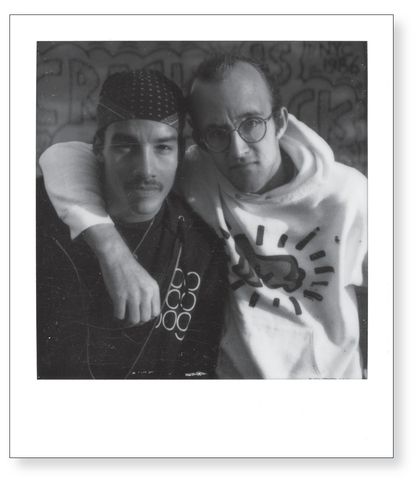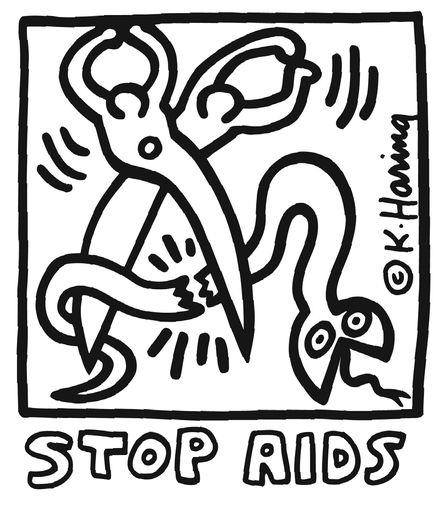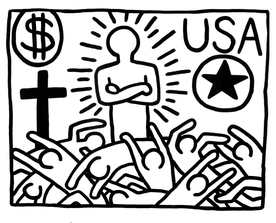Keith Haring Journals (23 page)
Read Keith Haring Journals Online
Authors: Keith Haring

This is where I think I share the most with Andy. I think the work I am doing and the direction my life and career have taken was completely determined by my graphic sensibility (my drawing style) and a careful evaluation and understanding of what that is and what it possesses within itself that determines its evolution. It’s about understanding not only the works, but the world we live in and the times we live in and being a kind of mirror of that. I think it happens really naturally and inevitably if you are honest with yourself and your times.
That is the reason I have the Pop Shop and why I can do a video for Grace Jones and why I can use computers, design sculpture parks, vodka ads, and make paintings without it contradicting itself. The line determines the work. The philosophy and attitude of the early work (i.e., the subway drawings, public murals, graphic contribution) determined the public-ness of the work. Popular culture ingests it whether I like it or not.
But of course I liked it, because that was the whole intention of the art: to affect and enter the culture by understanding it and reflecting it; to contribute to and broaden the concept of art and the artist as much as possible. Artists help us understand ourselves and our times through pictures, parables, and actions. Andy understood that better than anybody. His life was his art and his art was his life. They were practically indistinguishable.
Andy understood the idea of “modern” art, really “modern.” He lived a totally “modern” life. I think he reinvented “modern” art.
Andy had an incredible sense of timing. One thing I learned from going to a lot of parties and “social” events with Andy was that he always arrived at the right time. He’d always arrive when the party was in full swing, but before the peak. In fact, his entry would often be the height of the party and the signal that the party had actually “started.” His exits were equally well timed. I would often catch him slipping out without saying goodbye. It was, of course, too difficult to try to say goodbye to
everyone
, so he’d just leave when nobody would notice and then people would slowly realize and start saying, “Andy’s gone, when did he leave?” He didn’t want his exit to signal the “end” of the party, so he quietly slipped out when we least suspected it . . . mysteriously and with style. He left like he had left hundreds of parties . . . unnoticed leaving, but instantly missed; his absence both bewildering and unexpected. The party goes on, but something will be different. Andy is gone and I miss him already.
MARCH 28, 1987:everyone
, so he’d just leave when nobody would notice and then people would slowly realize and start saying, “Andy’s gone, when did he leave?” He didn’t want his exit to signal the “end” of the party, so he quietly slipped out when we least suspected it . . . mysteriously and with style. He left like he had left hundreds of parties . . . unnoticed leaving, but instantly missed; his absence both bewildering and unexpected. The party goes on, but something will be different. Andy is gone and I miss him already.
On a plane from Düsseldorf to New York City
A continuing contemplation brings me to the conclusion that all of this problem of “the surface” of painting stems from an inability to paint or to create an image of adequate strength. Even old painters were not obsessed with this problem of the surface. They are, in fact, quite thin. The illusion is created with color, perspective, space, composition, etc.
The current preoccupation with the surface, I think, stems from the painter’s inability to deal with the painting as an image itself.
Andy Warhol is a perfect example of the minimum requirement to create an image of timeless and monumental quality.
All of the unnecessary application of wax, straw, towels, broken plates, chairs, utensils and wood constructions, which serve to “build up” the surface, is merely an excuse for not knowing what to paint!
Most “modern” painting is lost in formal investigation, which better serves a pursuit of “science of materials” than a true pursuit of images and intervention, and art.
Any “real” intervention in the culture is beyond the limitations of materials and “formal elements.”
Material should be at the service of the painter, not a prerequisite to the painting itself.
Broken plates, straw, wax, and wooden constructions are only an excuse, and do not constitute an evolution of ideas. It is quite easy to “invent” new areas of discussion of “the surface” through artificial means. It is only a diversion from the real import of the thing itself.
Art is, after all, about the image we have before us, the lasting impact and effect that image has on us, not only the ego of the artist whose obsession with himself prevents him from seeing the larger picture.
Julian Schnabel is not a genius. He’s probably not even a great painter. I’m sure that he is interesting today in a limited capacity and he is very interesting for collectors and dealers, but in the long run, his contribution is slight. Joseph Beuys has already explored most of the territory of the ambiguous figurative abstraction that Julian Schnabel pretends to have invented.
Certainly his paintings can sometimes allude to “new inventions of nature” or things we have never seen before (new forms, etc.). However, what is this? Is this new, or even interesting?
His own conviction of his “importance” makes him even more difficult to digest. His obnoxious insistence on his importance disgusts me to the point of nausea. If he again attempts to make one of his self-referential speeches at Andy’s memorial on Wednesday, I promise I will do my best to end his speech as quickly as possible. Andy hated his speeches and would
never
have wanted him to speak at his memorial.
never
have wanted him to speak at his memorial.
Speaking of memorials . . .
After “accidentally” running into George Condo in Munich (I went there for Niki de Saint-Phalle’s show, but mostly to meet Jean Tinguely at his opening). The funniest thing was the big fat German ladies standing in front of Niki’s sculptures looking exactly like the big fat sculptures! Jean was fun as usual! Very fast and very fun. He brought masks to the boring lunch and turned the atmosphere around immediately!
Jean has made, finally, a sculpture for me in trade for a painting I did in Lausanne in 1983 or ’84. It was a two-sided painting I did as a “performance” in the museum during a show of “New Art” from America.

Anyway, George Condo’s show was quite incredible and very
George
! He’s still my favorite painter, with, of course, Jean-Michel Basquiat, still the
 of art . . .
of art . . .
George
! He’s still my favorite painter, with, of course, Jean-Michel Basquiat, still the
 of art . . .
of art . . .Anyway, the reason I started to write this (about memorials) was that in the supplement to George’s catalogue, there was an interview I read in the airplane from Munich to Düsseldorf. At first I was quite depressed because I was sure that I was not an intellectual after reading George’s interview. However, a few days of thought made the difference between our pursuits much clearer. And there is a
big difference
. We share some things, but much is different.
big difference
. We share some things, but much is different.
Anyway, there is one question George is asked about
life
and
art
and which is more important, and George said
art
is more important because it is immortal. This struck a very deep note inside me. For I am quite aware of the chance that I have or will have AIDS.
life
and
art
and which is more important, and George said
art
is more important because it is immortal. This struck a very deep note inside me. For I am quite aware of the chance that I have or will have AIDS.
The odds are very great and, in fact, the symptoms already exist. My friends are dropping like flies and I know in my heart that it is only
divine intervention
that has kept me alive this long. I don’t know if I have five months or five years, but I know my days are numbered.
divine intervention
that has kept me alive this long. I don’t know if I have five months or five years, but I know my days are numbered.
This is why my activities and projects are so important now.
To do as much as possible as quickly as possible
. I’m sure that what will live on after I die is important enough to make sacrifices of my personal luxury and leisure time now.
Work is all I have and art is more important than life
.
To do as much as possible as quickly as possible
. I’m sure that what will live on after I die is important enough to make sacrifices of my personal luxury and leisure time now.
Work is all I have and art is more important than life
.

Look at Andy. All of a sudden he is gone. All I have to remember and keep him alive is all of the
things
he left. Everything,
every
memory becomes invaluable, timeless.
But the “things” will survive me, the memories will die with me
.
things
he left. Everything,
every
memory becomes invaluable, timeless.
But the “things” will survive me, the memories will die with me
.
I’m not really scared of AIDS. Not for myself. I’m scared of having to watch more people die in front of me. Watching Martin Burgoyne or Bobby die was pure agony. I refuse to die like that. If the time comes, I think suicide is much more dignified and much easier on friends and loved ones. Nobody deserves to watch this kind of
slow death
.
slow death
.
I always knew, since I was young, that I would die young. But I thought it would be
fast
(an accident, not a disease). In fact, a man-made disease like AIDS. Time will tell, but I am not scared. I live every day as if it were the last.
I love life
. I love babies and children and some people, most people—well, maybe not
most
, but a lot of people!
fast
(an accident, not a disease). In fact, a man-made disease like AIDS. Time will tell, but I am not scared. I live every day as if it were the last.
I love life
. I love babies and children and some people, most people—well, maybe not
most
, but a lot of people!
I’ve been very lucky so far; luckier than many. I don’t take it for granted, I assure you. I appreciate everything that has happened, especially the
gift of life
I was given that has created a silent bond between me and children. Children can sense this “thing” in me. Almost all children have a special sense of this “thing” in other people.
They know
. Some special people also know these things. Most of my friends are this kind of person. Juan Rivera is this kind of person. That is why I love him, I’m sure. I’ve always been attracted to these special people. It is this quality that separates me from other artists. Maybe you don’t understand this now, but you will. I am different.
gift of life
I was given that has created a silent bond between me and children. Children can sense this “thing” in me. Almost all children have a special sense of this “thing” in other people.
They know
. Some special people also know these things. Most of my friends are this kind of person. Juan Rivera is this kind of person. That is why I love him, I’m sure. I’ve always been attracted to these special people. It is this quality that separates me from other artists. Maybe you don’t understand this now, but you will. I am different.
Many artists have this understanding of the world that separates them from it, but only some of them are truly special in a way that they can touch other people’s lives and pass through them. I’m sure when I die, I won’t really die, because I live in many people.
Spirits travel without limits. Andy is in me now. I knew before he died that he would never really die. He lives inside many people. He understood all of these things.
Most people never give him credit for this. He has an outward image of a manipulator, a “user” of people. In fact, the opposite is true—people used him and he let himself be used. He wanted to make things better for everyone else. He helped a lot of people to see themselves. He was not transparent, but maybe a mirror. Nobody can be responsible for other people’s lives. Everyone ultimately charts their own course.
You can only help and encourage people to live for themselves. The most evil people are the people who pretend to have the answers. The fundamentalist Christians, all dogmatic “control religions,” are evil. The original ideas are good. But they are so convoluted and changed that only a skeleton of good intentions is left. . . .
Most of the evil in the world is done in the name of good (religion, false prophets, bullshit artists, politicians,
businessmen
).
businessmen
).
The whole concept of “business” is evil.
Most white men are evil. The white man has always used religion as the tool to fulfill his greed and power-hungry aggression.
Business is only another name for control. Control of mind, body and spirit. Control is evil.

Other books
Higher Institute of Villainous Education by Mark Walden
DeVante's Curse by Johnson, S. M.
Broken Wings (The Broken Series Book 3) by Ruff, K.S.
The Slayer Chronicles: First Kill by Brewer, Heather
Happily Bedded Bliss: The Rakes of Cavendish Square by Tracy Anne Warren
Eternity Crux by Canosa, Jamie
Against Infinity by Gregory Benford
Three Wishes by Jenny Schwartz
The House of Daniel by Harry Turtledove